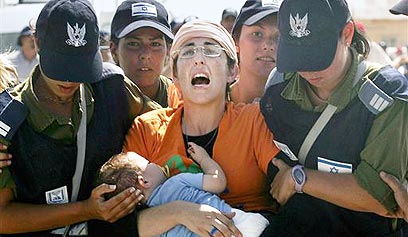
Only 35% of Gush Katif evacuees at permanent housing
Seven years after being removed from Gaza area homes, former settlers still struggling to adjust
Only 35% of families who were removed from Gaza in 2005 have permanent housing, according to a report released by the Gush Katif Committee to mark seven years since the Disengagement.
Also according to the report, unemployment rates among evacuees is at 16%, compared to 4% in 2005.
Related Stories
- Gush Katif evacuees not finding work
- Gush Katif evacuees suffering financial, medical problems
- Closing a dark chapter
"The fact that the state of Israel has failed to support Gush Katif evacuees was asserted two years ago by a state committe," said chairman of the Gush Katif Committee, Eliezer Orbach. "Ever since, there has been legislative efforts to help advance evacuees, but not enough."

2005 evacuation (Photo: Associated Press)
But some improvement has occurred; according to data collected by the JobKatif organization, which helps Gush Katif evacuees return to the job market, unemployment has now reached its lowest point in seven years, compared to 73% in 2006.
Remembering Gush Katif
Residents of the western Negev desert caravan site in Nitzana, which was designated as a transit stop en route to permanent dwelling, find it hard to believe that seven years after the disengagement, the place is still as populated as it is.
"This area was supposed to go back to being a watermelon field a long time ago," said Lior Kalfa, former Neve Dekalim settler. "Everyone is coping, both separately and together as a community. We try to stay positive".
According to Kalfa, Gush Katif commemorative walls are often found in Nitzana homes, and on its streets. This week, residents unveiled a large sign made entirely of Gush Katif olive trees.
Naama Zarbiv, a Gush Katif evacuee who temporarily resides in Amatzia, a moshav in south-central Israel, expressed hope to stay with her community, though she realizes it might not happen.
"Some people have lost their money and might not be able to afford a new house. My husband is without a job. He used to be an electrician in Gush Katif and here has nothing. I don’t know how we can afford to build a house, but we stay positive, as does our entire community."

Temporary residence (Photo: Tsafrir Abayov)
A report issued in 2010 stated that most permanent housing projects for evacuees have yet to be built; that unemployment rates among evacuees are twice as high as in the general population; and that many of the former settlers are in need of welfare assistance. "The recovery process of the evacuees is far from over," the report stated.
The date by which all former settlers were expected to have permanent residence was the end of 2011. Almost a year after that deadline, permanent housing for many of the evacuees has yet to be found.
On Thursday evening, an event commemorating seven years since the disengagement was jointly held by the Gush Katif Committee and the Begin Heritage Center. MK Zevulun Orlev (Habayit Hayehudi), Rabbi Michael Melchior and Elyashiv Reichner were to appear at the event, held in Jerusalem.
Various activities commemorating the disengagement were held around Israel, while activists around the world marked the anniversary with fundraising events, all proceeds of which were to be donated to the JobKatif organization.
- Receive Ynetnews updates directly to your desktop










